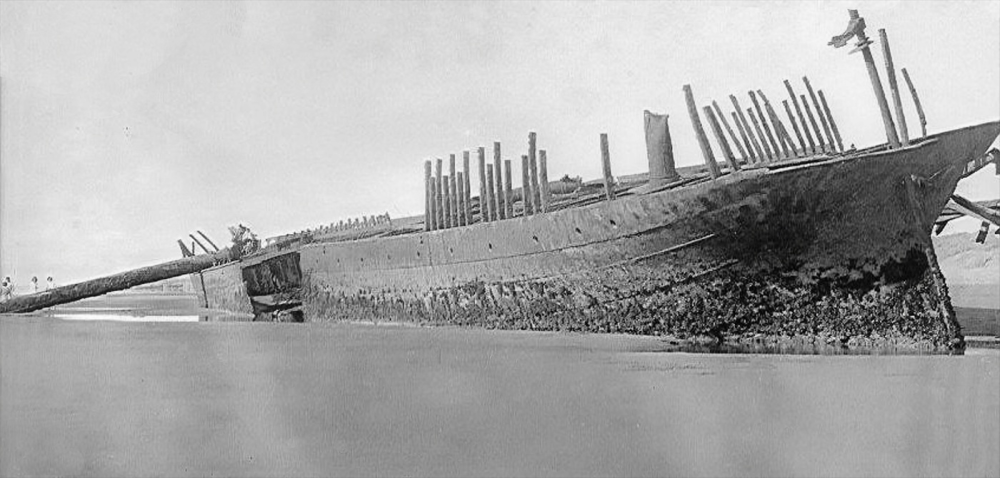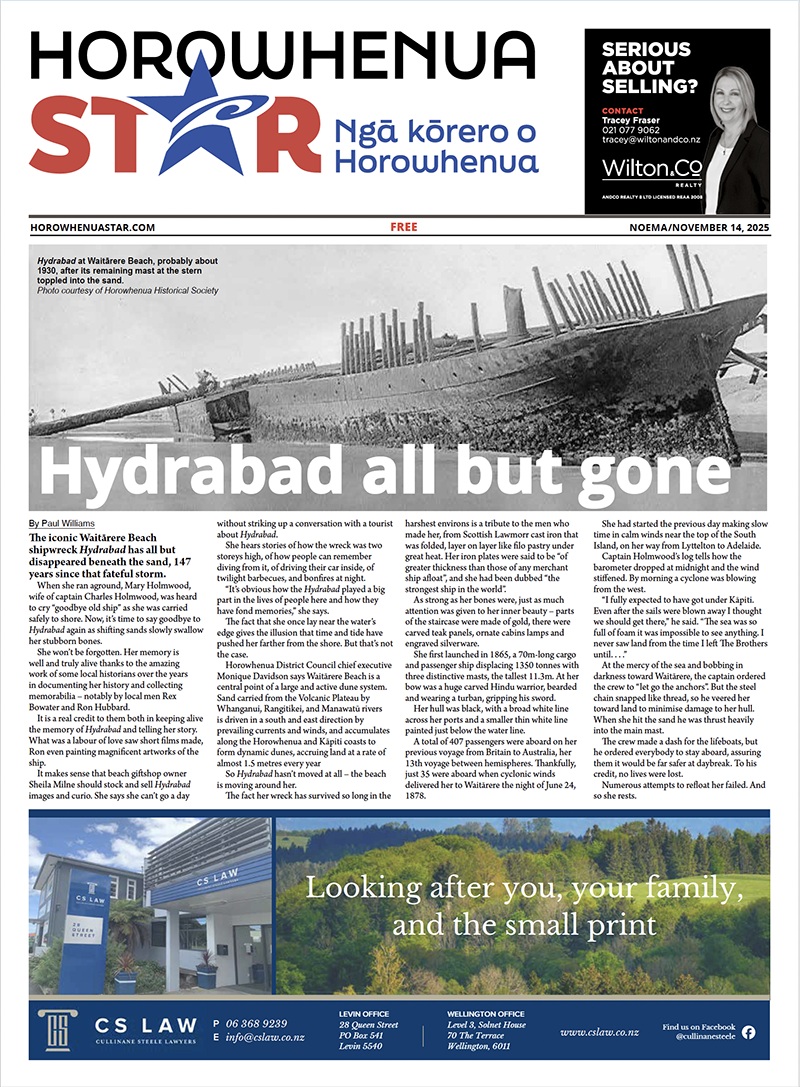
The iconic Waitārere Beach shipwreck Hydrabad has all but disappeared beneath the sand, 147 years since that fateful storm.
When she ran aground, Mary Holmwood, wife of captain Charles Holmwood, was heard to cry “goodbye old ship” as she was carried safely to shore. Now, it’s time to say goodbye to Hydrabad again as shifting sands slowly swallow her stubborn bones.

Hydrabad at Waitārere Beach, probably about 1930, after its remaining mast at the stern toppled into the sand. Photo courtesy of Horowhenua Historical Society
She won’t be forgotten. Her memory is well and truly alive thanks to the amazing work of some local historians over the years in documenting her history and collecting memorabilia – notably by local men Rex Bowater and Ron Hubbard.
It is a real credit to them both in keeping alive the memory of Hydrabad and telling her story. What was a labour of love saw short films made, Ron even painting magnificent artworks of the ship.
It makes sense that beach giftshop owner Sheila Milne should stock and sell Hydrabad images and curio. She says she can’t go a day without striking up a conversation with a tourist about Hydrabad.
She hears stories of how the wreck was two storeys high, of how people can remember diving from it, of driving their car inside, of twilight barbecues, and bonfires at night.
“It’s obvious how the Hydrabad played a big part in the lives of people here and how they have fond memories,” she says.
The fact that she once lay near the water’s edge gives the illusion that time and tide have pushed her farther from the shore. But that’s not the case.
Horowhenua District Council chief executive Monique Davidson says Waitārere Beach is a central point of a large and active dune system. Sand carried from the Volcanic Plateau by Whanganui, Rangitikei, and Manawatū rivers is driven in a south and east direction by prevailing currents and winds, and accumulates along the Horowhenua and Kāpiti coasts to form dynamic dunes, accruing land at a rate of almost 1.5 metres every year
So Hydrabad hasn’t moved at all – the beach is moving around her.
The fact her wreck has survived so long in the harshest environs is a tribute to the men who made her, from Scottish Lawmorr cast iron that was folded, layer on layer like filo pastry under great heat. Her iron plates were said to be “of greater thickness than those of any merchant ship afloat”, and she had been dubbed “the strongest ship in the world”.
As strong as her bones were, just as much attention was given to her inner beauty – parts of the staircase were made of gold, there were carved teak panels, ornate cabins lamps and engraved silverware.
She first launched in 1865, a 70m-long cargo and passenger ship displacing 1350 tonnes with three distinctive masts, the tallest 11.3m. At her bow was a huge carved Hindu warrior, bearded and wearing a turban, gripping his sword.
Her hull was black, with a broad white line across her ports and a smaller thin white line painted just below the water line.
A total of 407 passengers were aboard on her previous voyage from Britain to Australia, her 13th voyage between hemispheres. Thankfully, just 35 were aboard when cyclonic winds delivered her to Waitārere the night of June 24, 1878.
She had started the previous day making slow time in calm winds near the top of the South Island, on her way from Lyttelton to Adelaide.
Captain Holmwood’s log tells how the barometer dropped at midnight and the wind stiffened. By morning a cyclone was blowing from the west.
“I fully expected to have got under Kāpiti. Even after the sails were blown away I thought we should get there,” he said. “The sea was so full of foam it was impossible to see anything. I never saw land from the time I left The Brothers until. . . .”
At the mercy of the sea and bobbing in darkness toward Waitārere, the captain ordered the crew to “let go the anchors”. But the steel chain snapped like thread, so he veered her toward land to minimise damage to her hull. When she hit the sand he was thrust heavily into the main mast.
The crew made a dash for the lifeboats, but he ordered everybody to stay aboard, assuring them it would be far safer at daybreak. To his credit, no lives were lost.
Numerous attempts to refloat her failed. And so she rests.
OTHER STORIES
















